Modeling, Control and Power Management of Six-Phase PMSM Based Shipboard MVDC Distribution System
Abstract
1. Introduction
2. System Topology Description and Component Model
2.1. Variable Speed Diesel Engine Model
2.2. Six-Phase PMSM Model
2.3. PV Array Model
2.4. Battery Energy Storage System
2.5. Dc-Link Model
2.6. Propulsion Load Model
3. Hierarchical Control for MVDC Shipboard Microgrid
3.1. Primary Control
3.1.1. Primary Current Control
3.1.2. Primary Voltage Control
3.2. Secondary Control
3.3. PMS
4. Simulation Results
4.1. Loading Scenario Under Considerations
4.2. Verification of Six-Phase PMSM Operations
4.3. Full System Simulation Under Berth-Out and Berth-In Mode
4.3.1. Berth-Out Mode
4.3.2. Berth-In Mode
5. Conclusions
Author Contributions
Funding
Acknowledgments
Conflicts of Interest
Appendix A. Design Parameters of System Components
| Parameter | Generator | Motor | Unit |
|---|---|---|---|
| Rated Power | 3 | 2 | MW |
| Number of pole pairs, | 2 | 6 | - |
| Magnetizing inductance, | 3.3315 | 3.331 | mH |
| Leakage inductance, | 1.5 | 1.1 | mH |
| Rotor flux linkage amplitude, | 4.759 | 4.759 | Wb |
| Stator phase winding resistance, | 0.02425 | 0.002425 | ohm |
| Switching frequency of ac–dc converter, | 3 | 3 | kHz |
| Time delay, | 16.6 | 16.6 | ms |
| Linear to angular speed conversion factor, | - | 1.6427 | - |
| Parameter | Value | Unit |
|---|---|---|
| Rated power of PV array | 200 | kW |
| Maximum power point voltage at STC | 1530 | V |
| FIBC inductance value, | 3 | mH |
| Dc-link capacitance value, | 95,500 | µF |
| PV side capacitance value, | 5000 | µF |
| ESR of the inductor, | 0.005 | ohm |
| ESR of the capacitor, | 0.002 | ohm |
| Switching frequency if FIBC, | 5 | kHz |
| DC bus voltage, | 6 | kV |
| Parameter | Value | Unit |
|---|---|---|
| Rated power of BESS | 600 | kWh |
| Nominal rated voltage of BESS, | 1200 | V |
| IBC inductance value, | 4.5 | mH |
| Dc-link capacitance value, | 95,500 | µF |
| Switching frequency if IBC, | 10 | kHz |
| DC bus voltage, | 6 | kV |
References
- Yang, T.; Cox, T.; Degano, M.; Bozhko, S.; Gerada, C. History and Recent advancements of Electric Propulsion and Integrated Electrical Power Systems for Commercial & Naval Vessels. In Proceedings of the International Naval & Maritime Exhibition and Congress for Latin America, ExpoNAVAL 2016, Vina Del Mar, Chile, 29 November–2 December 2016. [Google Scholar]
- Hansen, J.F.; Wendt, F. History and State of the Art in Commercial Electric Ship Propulsion, Integrated Power Systems, and Future Trends. Proc. IEEE 2015, 103, 2229–2242. [Google Scholar] [CrossRef]
- Sulligoi, G.; Vicenzutti, A.; Menis, R. All-Electric Ship Design: From Electrical Propulsion to Integrated Electrical and Electronic Power Systems. IEEE Trans. Transp. Electrif. 2016, 2, 507–521. [Google Scholar] [CrossRef]
- Bosich, D.; Vicenzutti, A.; Pelaschiar, R.; Mensi, R.; Sulligoi, G. Toward the future: The MVDC large ship research program. In Proceedings of the AEIT International Annual Conference, Naples, Italy, 14–16 October 2015. [Google Scholar]
- IEEE Recommended Practice for 1 kV to 35 kV Medium-Voltage DC Power Systems on Ships; in IEEE Standard 1709–2010. Available online: https://ieeexplore.ieee.org/document/5623440 (accessed on 20 March 2020).
- Doerry, N.; Amy, J.V. Design Considerations for a Reference MVDC Power System. In Proceedings of the SNAME Maritime Convention, Bellevue, WA, USA, 1–5 November 2016; Available online: https://www.onepetro.org/conference-paper/SNAME-SMC-2016-022 (accessed on 20 March 2020).
- Kim, K.; Park, K.; Roh, G.; Chun, K. DC-grid system for ships: A study of benefits and technical considerations. J. Int. Marit. Saf. Environ. Aff. Shipp. 2018, 2, 1–12. [Google Scholar] [CrossRef]
- Symington, W.P.; Belle, A.; Nguyen, H.D.; Binns, J.R. Emerging technologies in marine electric propulsions. J. Eng. Maritime Environ. 2014, 203, 187–198. [Google Scholar] [CrossRef]
- Ghenai, C.; Bettayeb, M.; Brdjanin, B.; Hamid, A.K. Hybrid solar PV/PEM fuel Cell/Diesel Generator power system for cruise ship: A case study in Stockholm, Sweden. Case Stud. Therm. Eng. 2019, 14, 65–76. [Google Scholar] [CrossRef]
- Satpathi, K.; Balijepalli, M.; Ukil, A. Modeling and Real-Time Scheduling of DC Platform Supply Vessel for Fuel Efficient Operation. IEEE Trans. Transp. Electrif. 2017, 3, 762–778. [Google Scholar] [CrossRef]
- Lee, K.J.; Shin, D.S.; Lee, J.P.; Yoo, D.W.; Choi, H.K.; Kim, H.J. Hybrid photovoltaic/diesel green ship operating in standalone and grid-connected mode–Experimental investigation. Energy 2013, 49, 475–483. [Google Scholar] [CrossRef]
- Javaid, U.; Freijedo, F.D.; Dujic, D.; Merwe, W.V.D. MVDC supply technologies for marine electrical distribution systems. CPSS Trans. Power Electron. Appl. 2018, 3, 65–76. [Google Scholar] [CrossRef]
- Tessarolo, A.; Castellan, S.; Menis, R.; Sulligoi, G. Electric generation technologies for all-electric ships with Medium-Voltage DC power distribution systems. In Proceedings of the IEEE Electric Ship Technologies Symposium, Arlington, VA, USA, 22–24 April 2013. [Google Scholar]
- McCoy, T.J. Trends in ship electric propulsion. In Proceedings of the IEEE Power Engineering Society Meeting, Chicago, IL, USA, 21–25 July 2002. [Google Scholar]
- Ourora, A.; Jackson, J.R.; Beno, J.H.; Thompson, R.C.; Schroeder, E. Modeling and Simulation of electric ship’s power system components and their interaction. In Proceedings of the Summer Computer Simulation Conference, San Diego, CA, USA, 15–18 July 2007. [Google Scholar]
- Sulligoi, G.; Tessarolo, A.; Benucci, V.; Baret, M.; Rebora, A.; Taffone, A. Modeling, simulation and experimental validation of generation system for Medium-Voltage DC Integrated Power Systems. In Proceedings of the IEEE Electric Ship Technologies Symposium, Baltimore, MD, USA, 20–22 April 2009. [Google Scholar]
- Sulligoi, G.; Tessarolo, A.; Benucci, V.; Trapani, A.M.; Baret, M.; Luise, F. Shipboard Power Generation: Design and development of a medium-voltage dc generation system. IEEE Ind. Appl. Mag. 2013, 19, 47–55. [Google Scholar] [CrossRef]
- Tessarolo, A. Experimental performance assessment of multiphase alternators supplying multiple AC/DC converters. J. Energy Power Eng. 2010, 4, 43–50. [Google Scholar]
- Kumar, J.; Agarwal, A.; Agarwal, V. A review on overall control of DC microgrids. J. Energy Storage 2019, 21, 123–138. [Google Scholar] [CrossRef]
- Gao, F.; Kan, R.; Cao, J.; Yang, T. Primary and secondary control in DC microgrid: A review. J. Mod. Power Syst. Clean Energy 2019, 7, 227–242. [Google Scholar] [CrossRef]
- Zhoxia, X.; Tianli, Z.; Huaimin, L.; Guerrero, J.M. Coordinated Control of a Hybrid-Electric-Ferry. IEEE Trans. Transp. Electrif. 2019, 5, 828–839. [Google Scholar] [CrossRef]
- Dinh, T.Q.; Bui, T.M.N.; Marco, J.; Watts, C.; Yoon, J.I. Optimal Energy Management for Hybrid Electric Dynamic Positioning Vessels. IFPAC PapersOnLine 2018, 51, 98–103. [Google Scholar] [CrossRef]
- Hou, J.; Sun, J.; Hofmann, H.F. Mitigating Power Flucations in Electric Ship Propulsion with Hybrid Energy Storage System: Design and Analysis. IEEE J. Ocean Eng. 2018, 43, 93–107. [Google Scholar] [CrossRef]
- Papalambrou, G.; Samokhin, S.; Topaloglou, S.; Planakis, N.; Kyrtatos, N.; Zenger, K. Model Predictive Control for Hybrid Diesel-Electric Marine Propulsion. IFAC PapersOnLine 2017, 50, 11064–11069. [Google Scholar] [CrossRef]
- Vu, T.V.; Gonsoulin, D.; Perkins, D.; Diaz, F.; Vahedi, H.; Edrington, C.S. Predictive Energy Management for MVDC All-Electric Ships. In Proceedings of the IEEE Electric Ship Technologies Symposium (ESTS), Arlington, VA, USA, 15–17 August 2017. [Google Scholar]
- Vu, T.L.; Ayu, A.A.; Dhupia, J.S.; Kennedy, L.; Adnanes, A.K. Power Management for Electric Tugboats Through Operating Load Estimation. IEEE Trans. Control Syst. Technol. 2015, 23, 2375–2382. [Google Scholar] [CrossRef]
- Yuan, L.C.W.; Tjahjowidodo, T.; Lee, G.S.G.; Chan, R.; Adnanes, A.K. Equivalent Consumption Minimization Strategy for hybrid all-electric tugboats to optimize fuel savings. In Proceedings of the American Control Conference, Boston, MA, USA, 6–8 July 2016. [Google Scholar]
- Kenellos, F.D.; Anavari-Moghaddam, A.; Guerrero, J.M. Smart Shipboard Power System Operation and Management. Inventions 2016, 1, 22. [Google Scholar] [CrossRef]
- Farhan, B.S.; Wang, S.; Salih, H.W. Control of Variable Speed Diesel Generator using FOC in Hybrid Systems. Int. J. Control Autom. 2016, 9, 111–122. [Google Scholar] [CrossRef]
- Lee, J.H.; Lee, S.H.; Sul, S.K. Variable-Speed Engine Generator with Supercapacitor: Isolated Power Generation System and Fuel Efficiency. IEEE Trans. Ind. Appl. 2009, 45, 2130–2135. [Google Scholar]
- Choi, I.; Jeung, Y.C.; Lee, D.C. Variable Speed Control of Diesel Engine-Generator using Sliding Mode Control. In Proceedings of the IEEE Transportation Electrification Conference and Expo, Harbin, China, 2–5 August 2017. [Google Scholar]
- Syverud, T.H. Modeling and Control of a DC-grid Hybrid Power System with Battery and Variable Speed Diesel Generators. Master’s Thesis, Norwegian University of Science and Technology, Trondheim, Norway, June 2016. [Google Scholar]
- Bojoi, R.; Tenconi, A.; Profumo, F.; Griva, G.; Martinello, D. Complete Analysis and Comparative Study of Digital Modulation Technique for Dual Three-Phase AC motor Drives. In Proceedings of the IEEE Annual Power Electronics Specialists Conference, Queensland, Australia, 24–27 June 2002. [Google Scholar]
- Zhang, K.; Kojabadi, H.M.; Wang, P.Z.; Chang, L. Modeling of a Converter-Connected Six-Phase Permanent Magnet Synchronous Generator. In Proceedings of the International Conference on Power Electronics and Drive Systems, Kuala Lampur, Malaysia, 28 November–1 December 2005. [Google Scholar]
- Duran, M.J.; Kouro, S.; Wu, B.; Levi, E.; Barrero, F.; Alepuz, S. Six-phase PMSG wind energy conversion system based on medium-voltage multilevel converter. In Proceedings of the European Conference on Power Electronics and Applications, Birmingham, UK, 30 August–1 September 2011. [Google Scholar]
- Tomer, A.S.; Dubey, S.P. Performance Analysis of Two Inverter Fed Six Phase PMSM Drive. In Proceedings of the Nirma University International Conference on Engineering, Ahmedabad, India, 28–30 November 2013. [Google Scholar]
- Hoem, Q.M.M. Control of Six-Phase Machines. Master’s Thesis, Norwegian University of Science and Technology, Trondheim, Norway, June 2009. [Google Scholar]
- Spagnolo, G.S.; Papalilo, D.; Martocchia, A. Eco friendly electric propulsion boat. In Proceedings of the International Conference on Environment and Electrical Engineering, Rome, Italy, 8–11 May 2011. [Google Scholar]
- Katagi, T.; Fugii, Y.; Nishikawa, E.; Hashimoto, T.; Ishida, K. Photovoltaic Generating System on Ships to Reduce Fossil Fuel Dependence. Available online: http://archive.jime.jp/e/publication/bulletin/english/pdf/mv24n021996p70.pdf (accessed on 20 March 2020).
- Kobougies, I.; Tatakis, E.; Prousalidis, J. PV system Installed in Marine Vessels: Technologies and Specifications. Adv. Power Electron. 2013, 2013, 831560. [Google Scholar] [CrossRef]
- Kabalo, M.; Paire, D.; Blunier, B.; Bouquain, D.; Simoes, M.C.; Miraoui, A. Experimental evaluation of four-phase floating interleaved boost converter design and control for fuel cell applications. IET Power Electron. 2012, 6, 215–226. [Google Scholar] [CrossRef]
- Zahedi, B.; Norum, L.E.; Ludvigsen, K.B. Optimized efficiency of all-electric ships by dc hybrid power systems. J. Power Sources 2014, 255, 341–354. [Google Scholar] [CrossRef]
- Boveri, A.; Silvestro, F.; Molinas, M.; Skjong, E. Optimal Sizing of Energy Storage Systems for Shipboard applications. IEEE Trans. Energy Convers. 2019, 34, 801–811. [Google Scholar] [CrossRef]
- Zhang, J. Bidirectional DC-DC Power Converter Design Optimization, Modeling and Control. Ph.D. Thesis, Virginia Polytechnic Institute and State University, Blacksburg, VA, USA, 30 January 2008. [Google Scholar]
- Anil, L.; Lidan, Z.; Yao, G.; Luqman, M. LCL Filter Based Grid-Connected Photovoltaic System with Battery Energy Storage. In Proceedings of the 14th IEEE Conference on Industrial Electronics and Applications (ICIEA), Xian, China, 19–21 June 2019. [Google Scholar]
- Liserre, M.; Blaabjerg, F.; Hansen, S. Design and Control of an LCL-Filter-Based Three-phase Active Rectifier. IEEE Trans. Ind. Appl. 2005, 2, 1281–1291. [Google Scholar] [CrossRef]
- Zhang, H.; Yao, G.; Lidan, Z.; Mei, B.; Li, D. Sliding Mode Control Based on Six-Phase PMSM Speed Control System. In Proceedings of the 43rd Annual Conference of the IEEE Industrial Electronics, Beijing, China, 29 October–1 November 2017. [Google Scholar]
- Karttunen, J.; Kallio, S.; Peltoniemi, P.; Silventoinen, P.; Pyrhonen, O. Dual Three-Phase Permanent Magnet Synchronous Machine Supplied by Two Independent Voltage Source Inverters. In Proceedings of the International Symposium on Power Electronics, Electrical Drives, Automation and Motion, Sorrento, Italy, 20–22 June 2012. [Google Scholar]
- Wang, P.; Lu, X.; Yang, X.; Wang, W.; Xu, D. An Improved Distribution Secondary Control Method for DC Microgrids with Enhanced Dynamic Current Sharing Performance. IEEE Trans. Power Electron. 2016, 31, 6658–6673. [Google Scholar] [CrossRef]
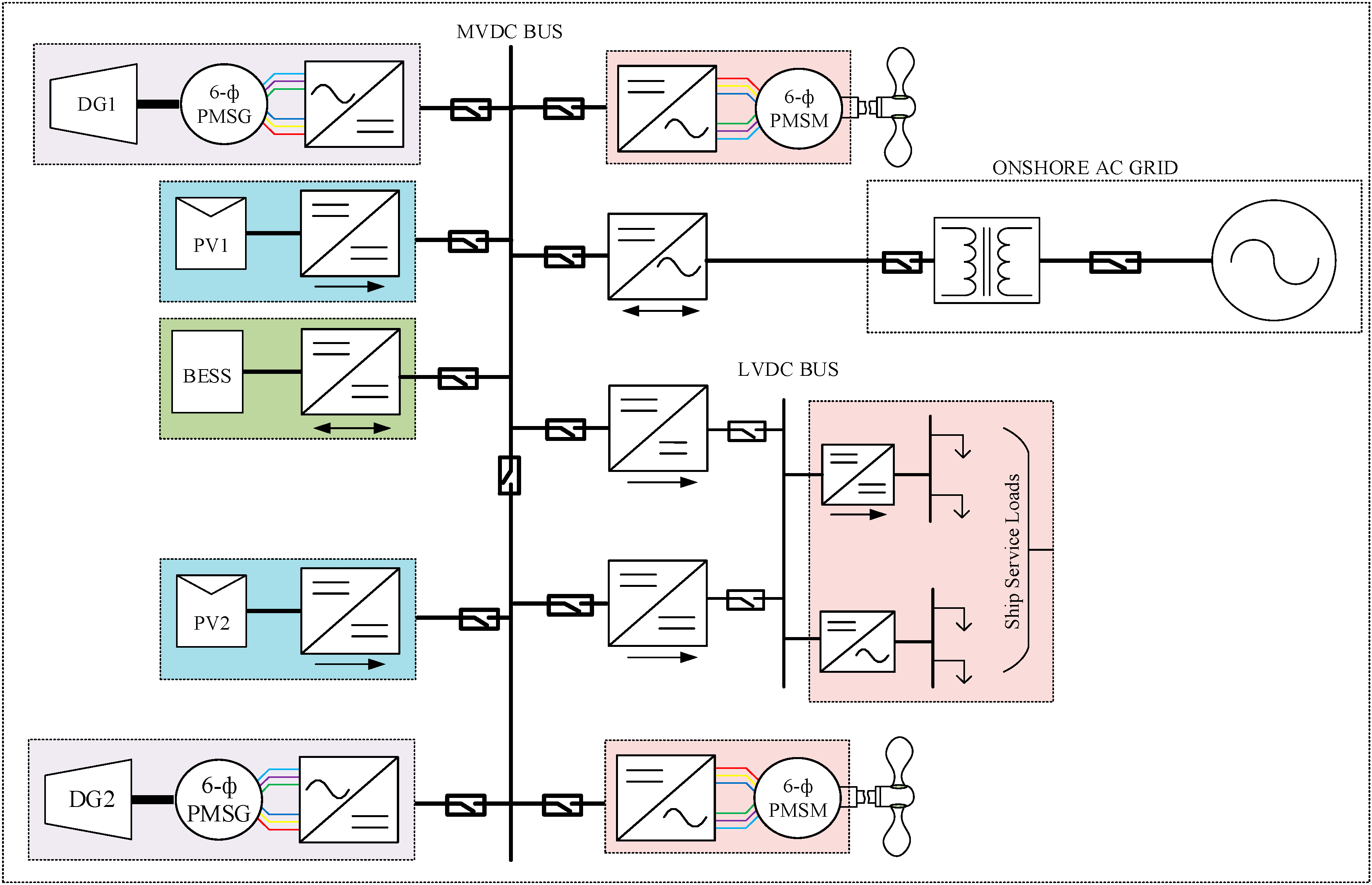


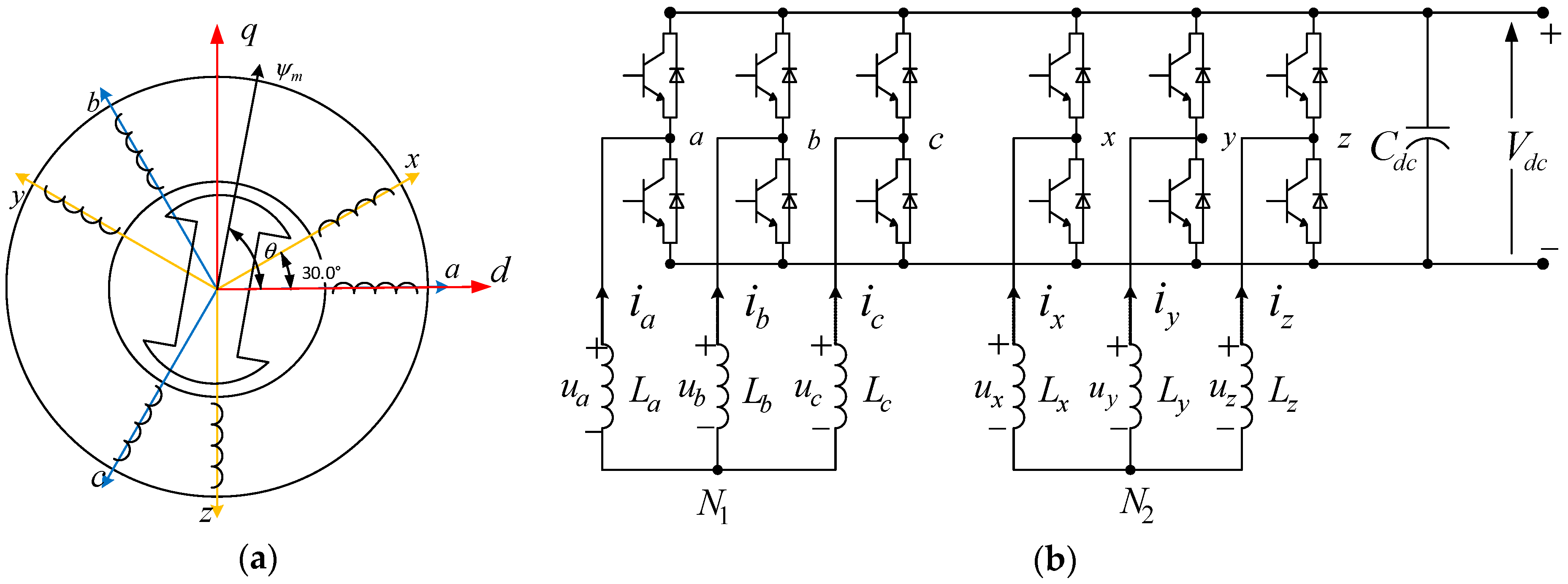

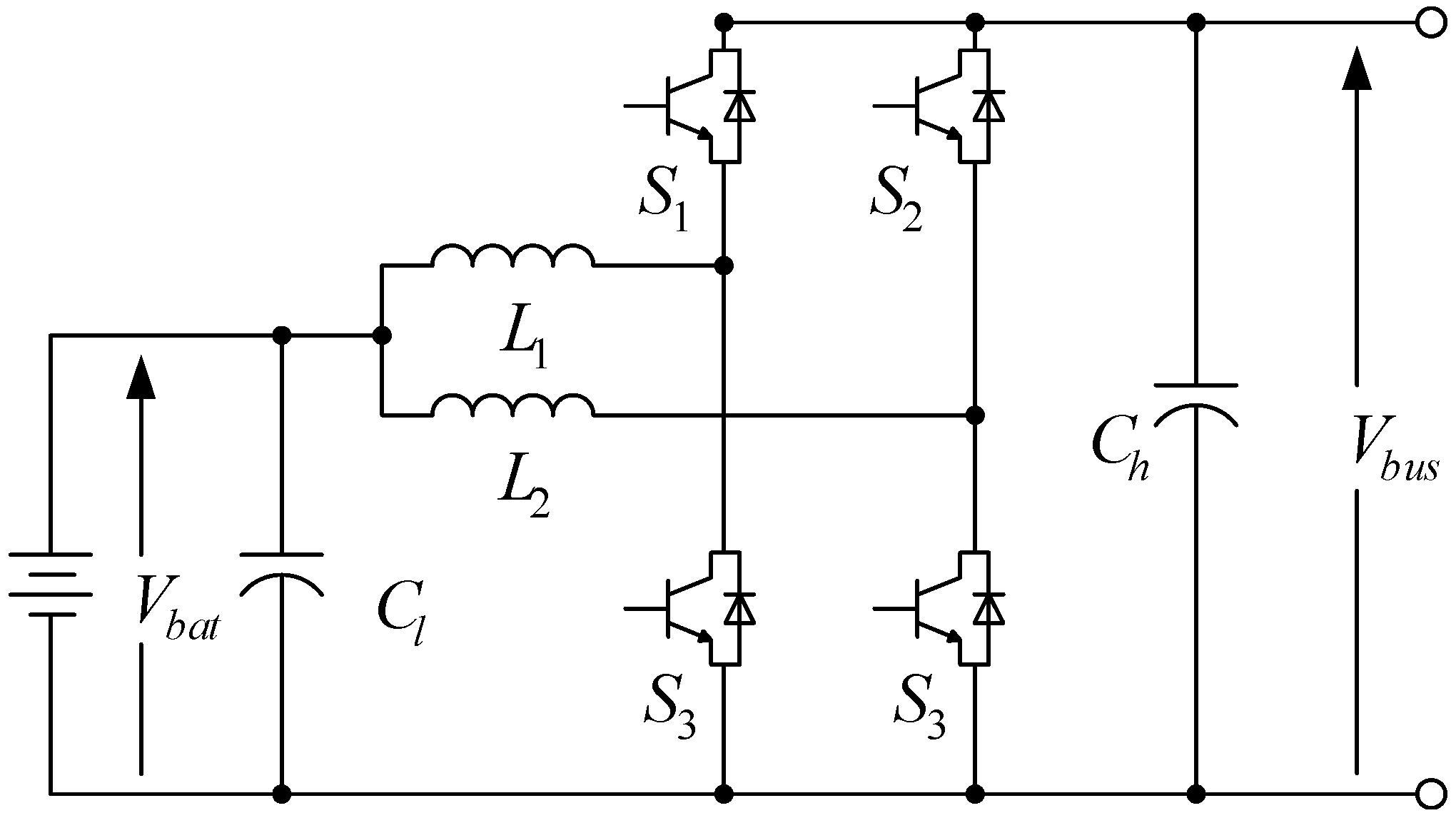
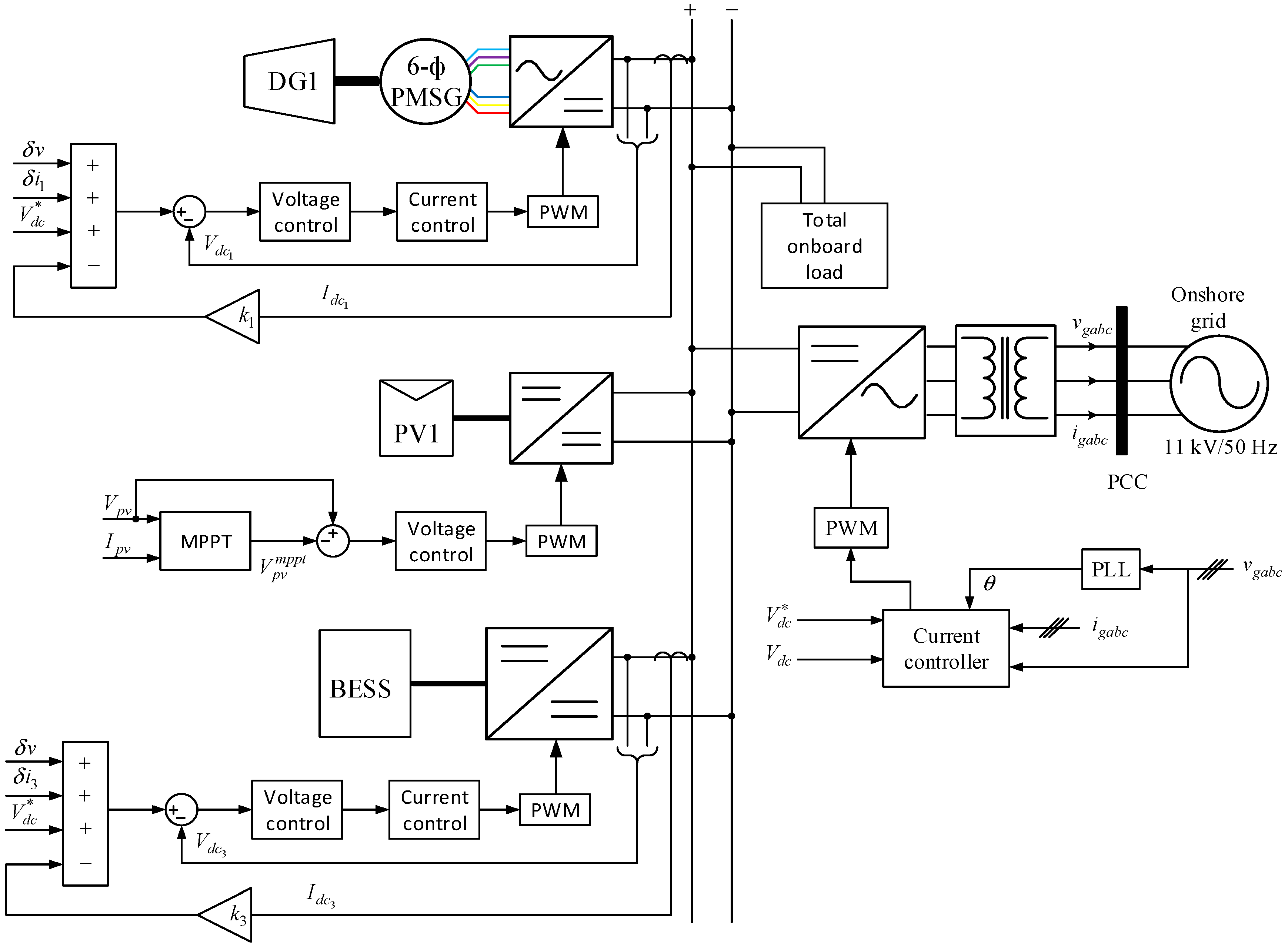
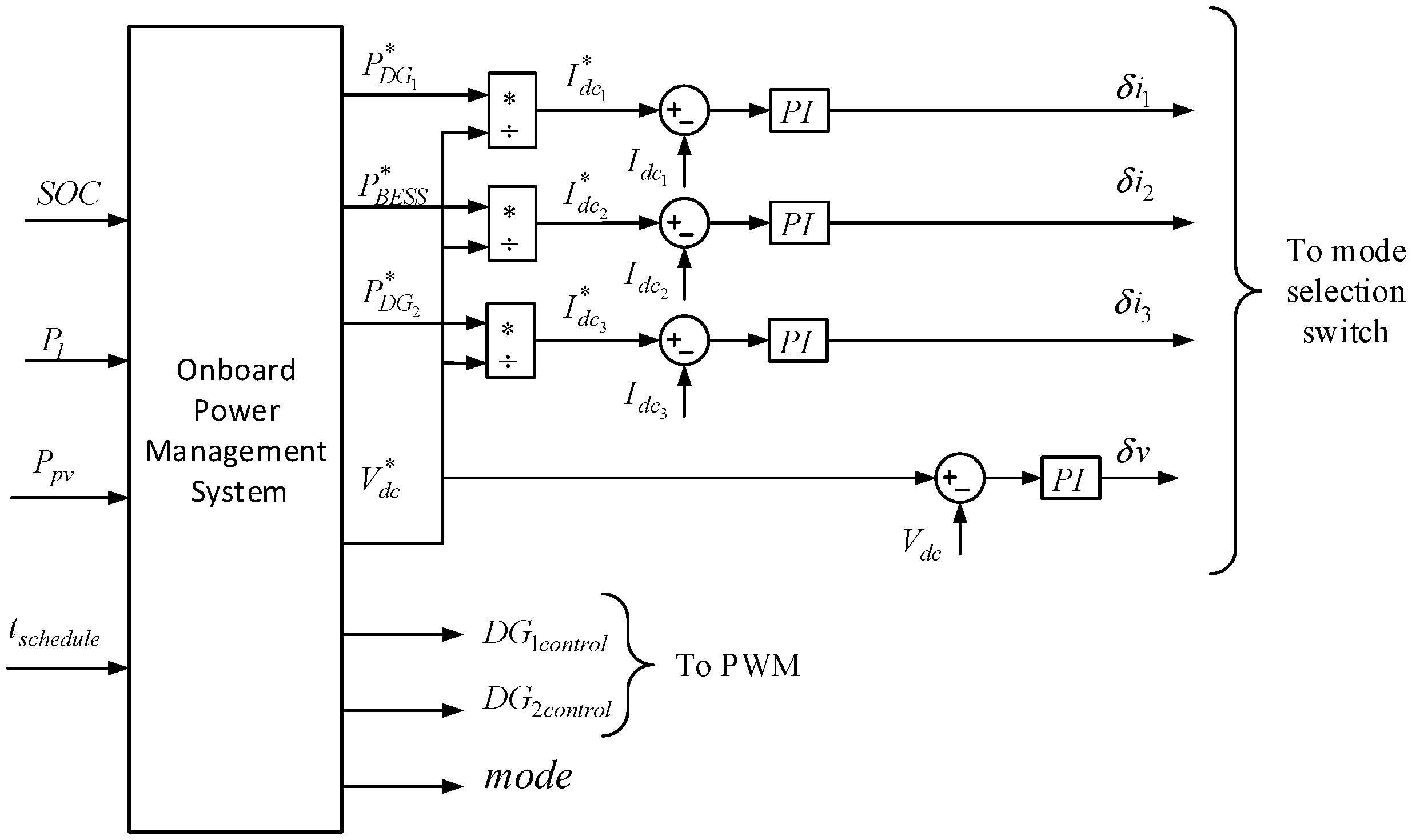
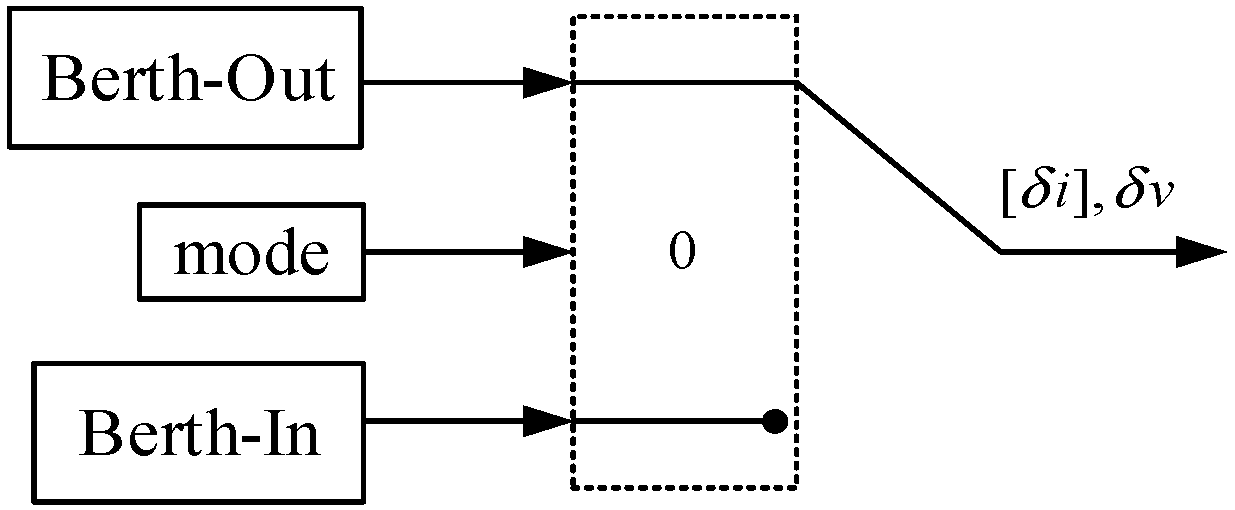


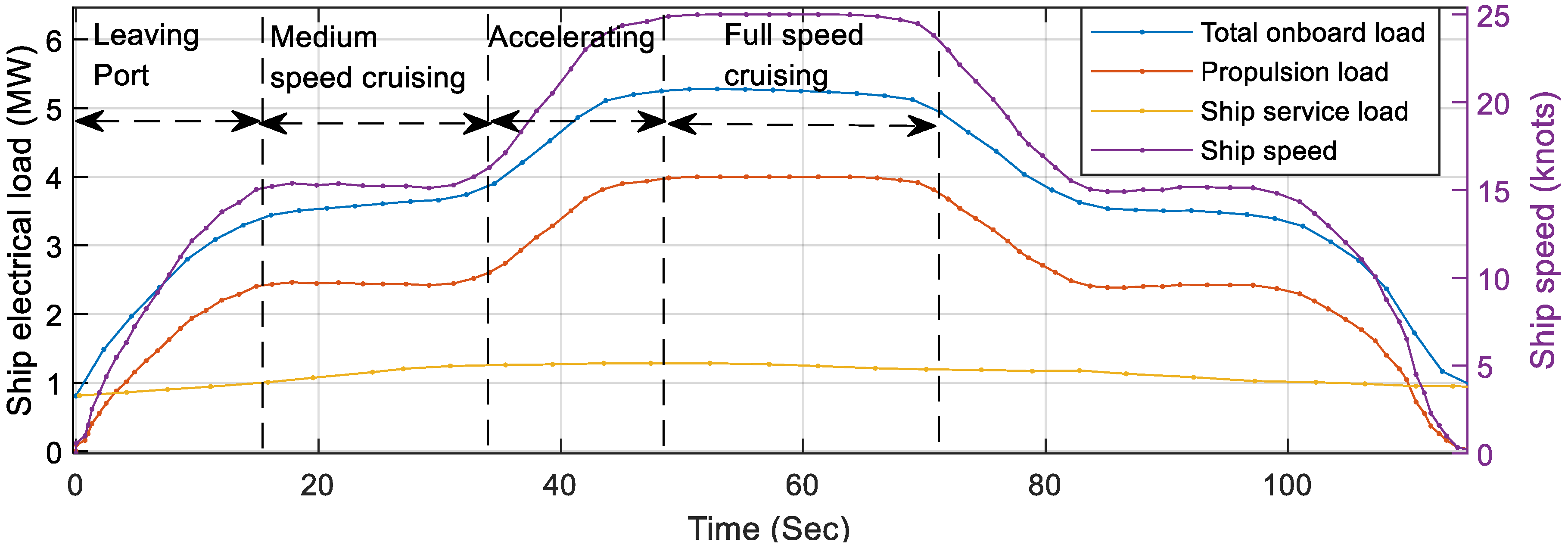

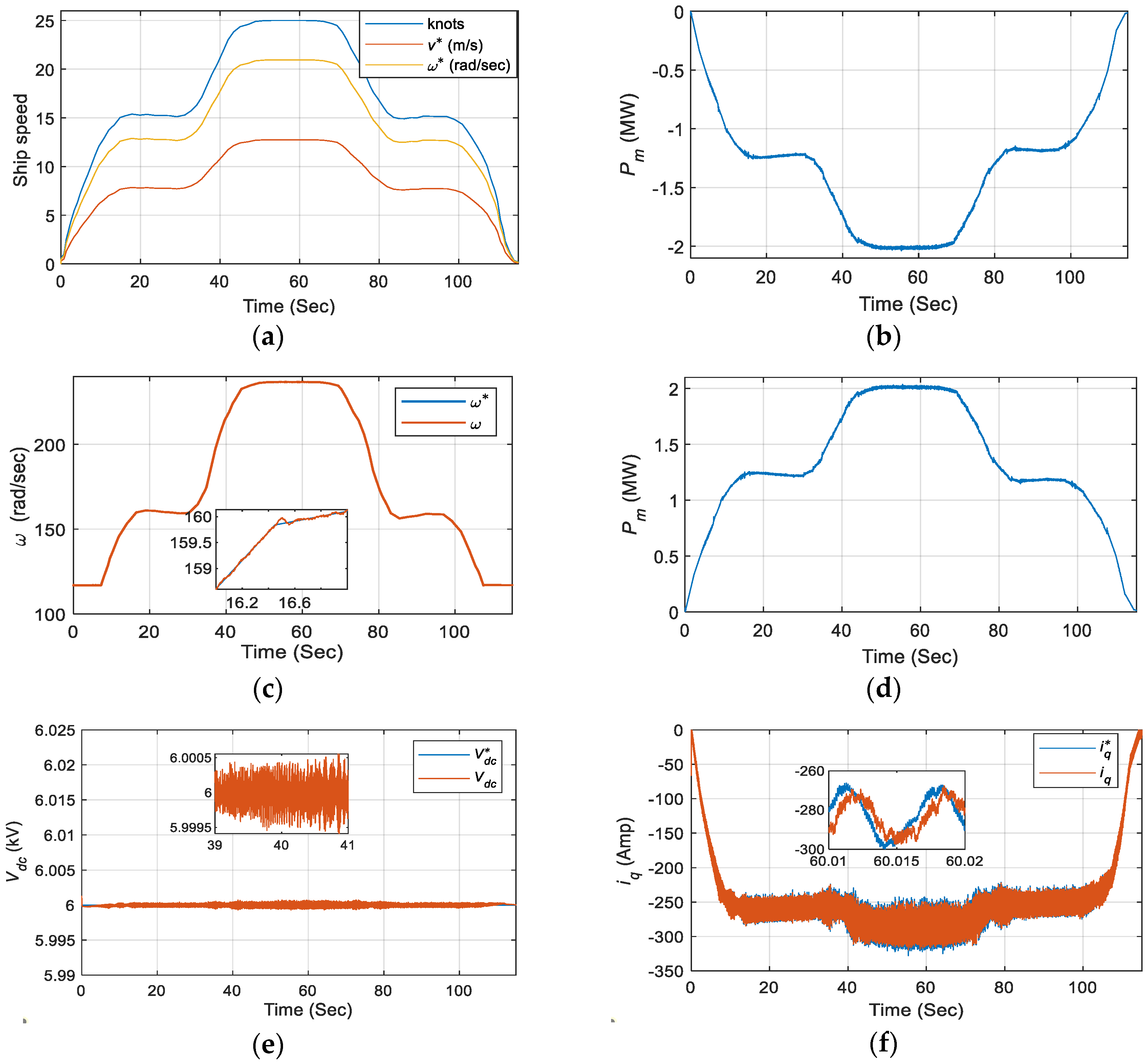


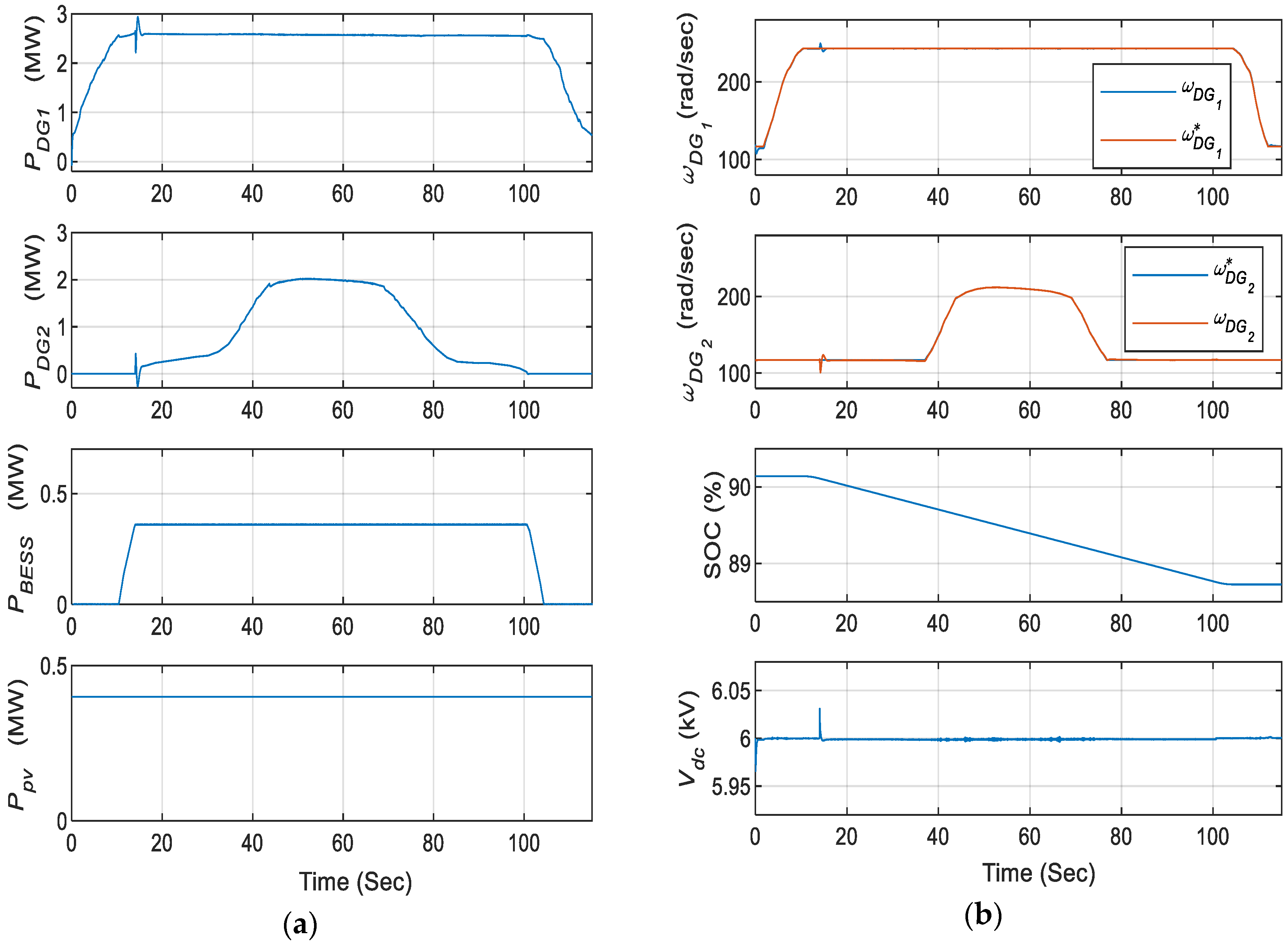
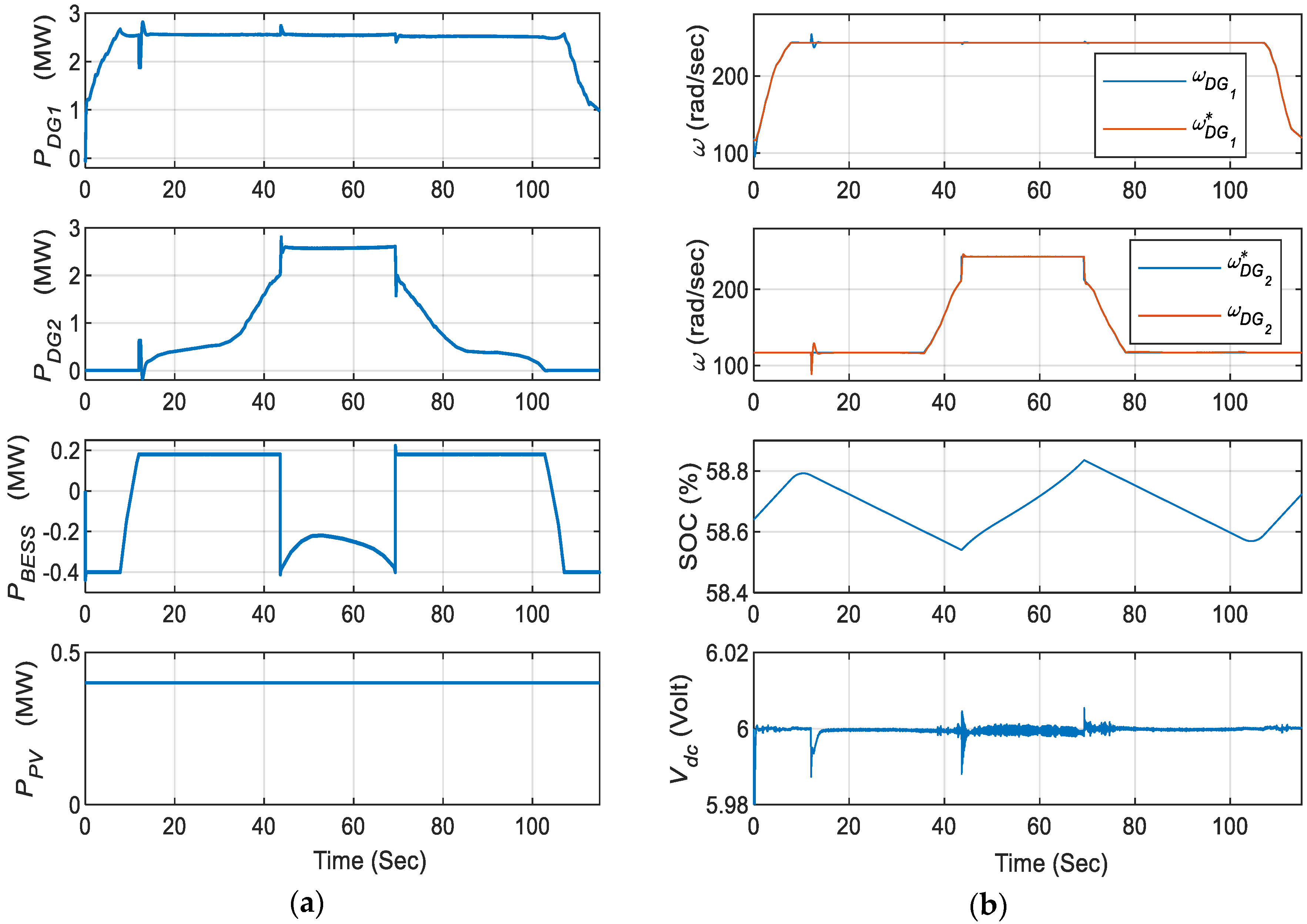
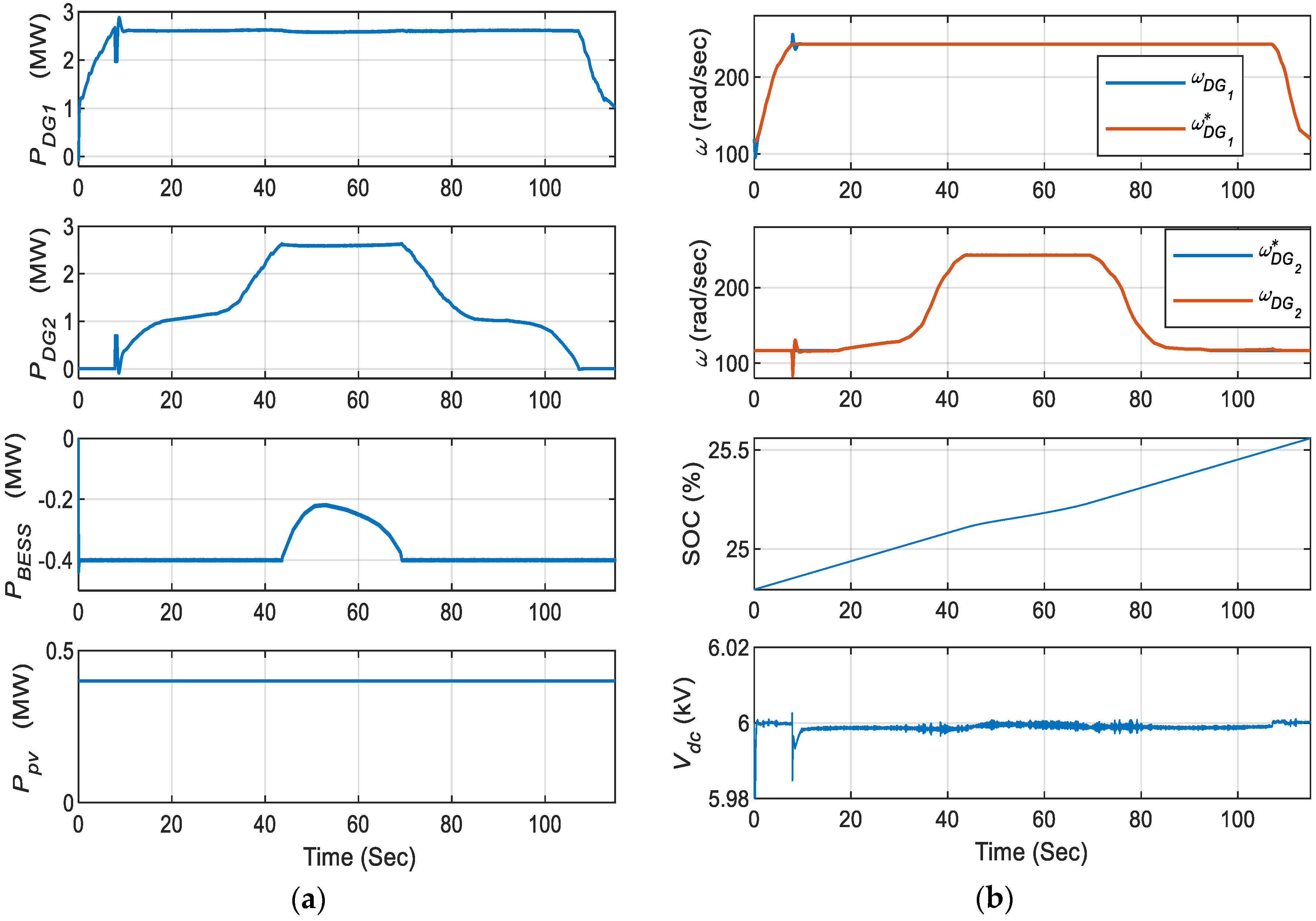
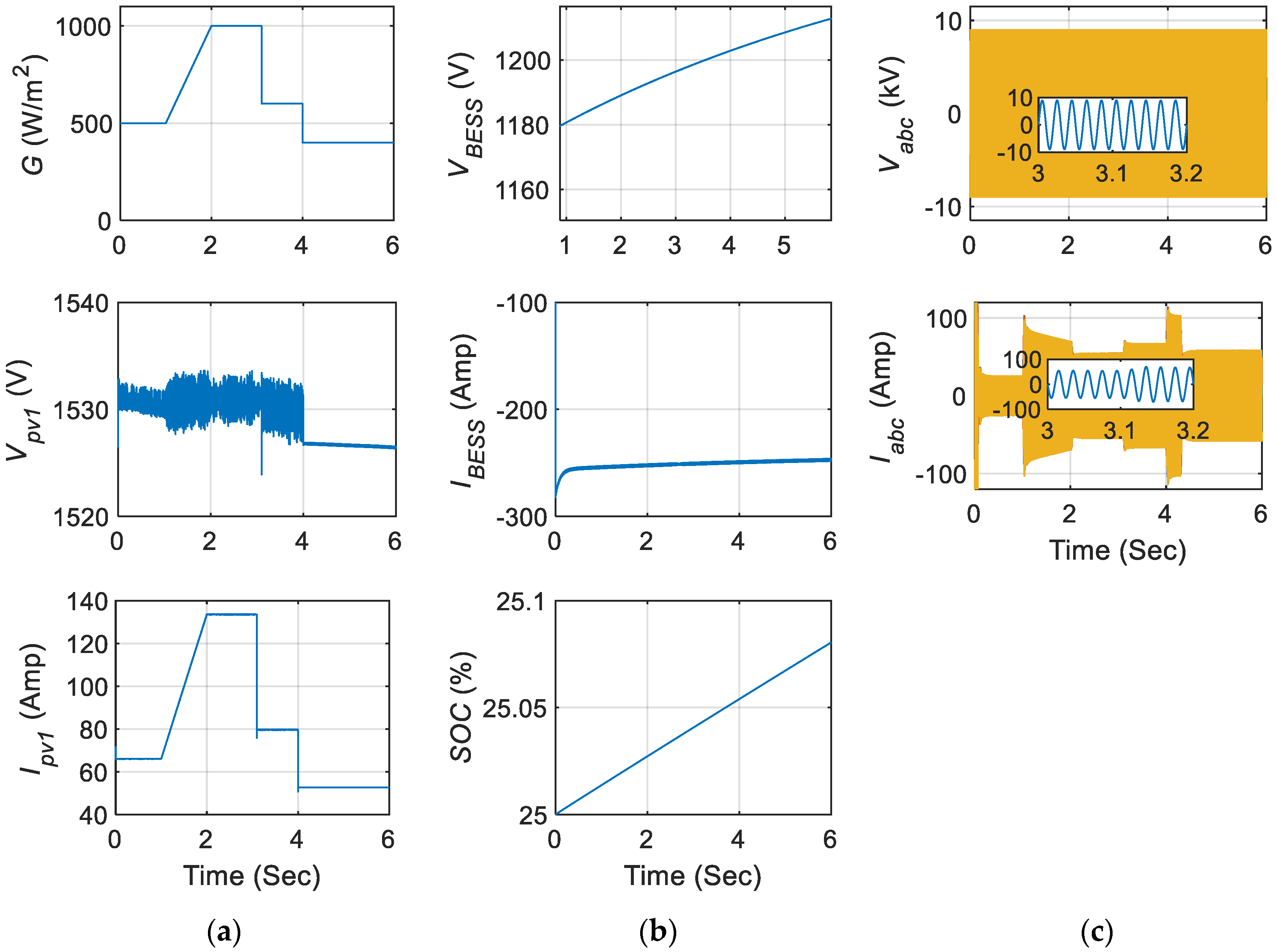
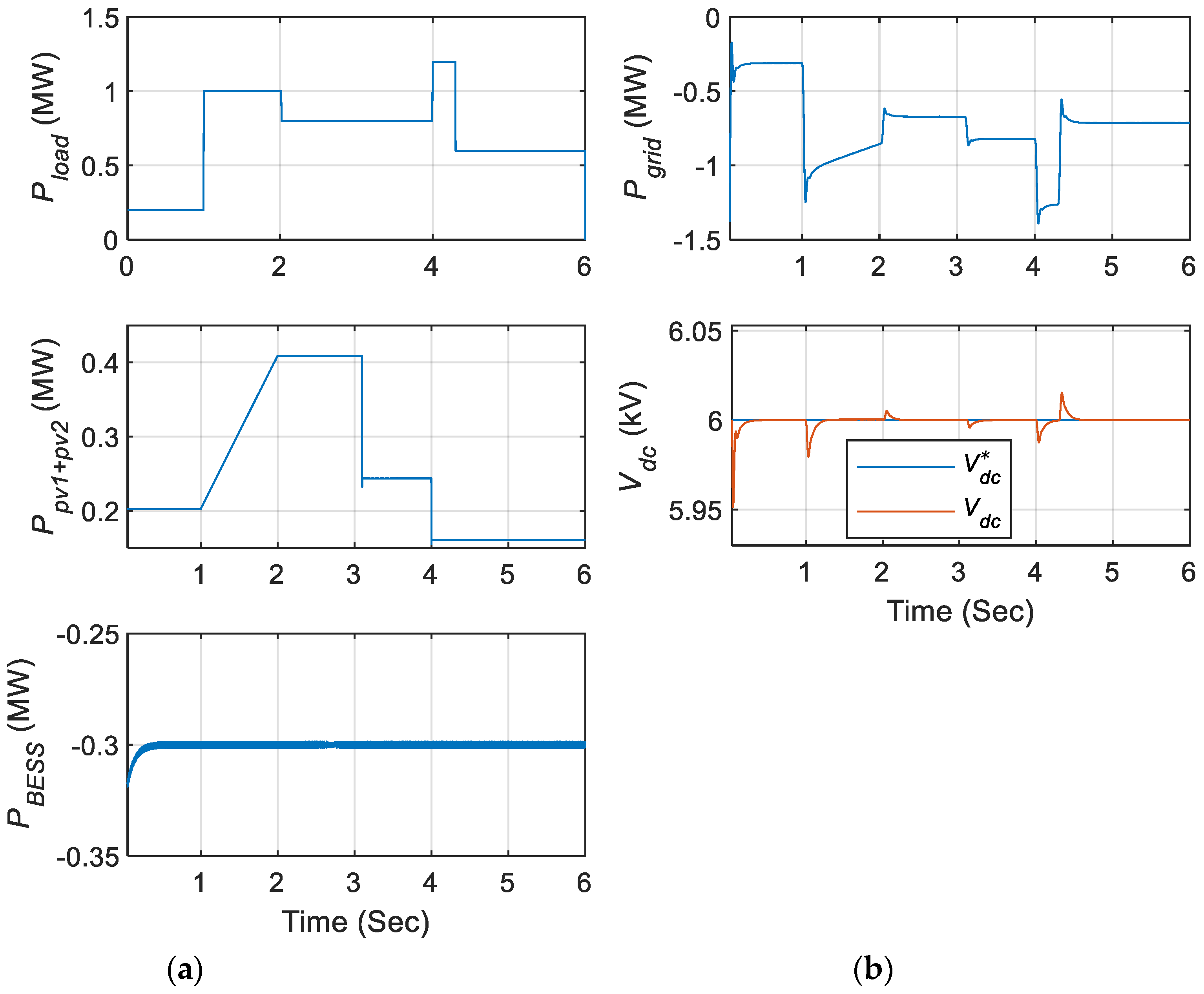
| BESS Condition | Loading Case | PMS Action |
|---|---|---|
| if | if | |
| else if | ||
| else if | ||
| else | ||
| else if | if | |
| else if | ||
| else if | ||
| else | ||
| else | if | |
| else if | ||
| else |
© 2020 by the authors. Licensee MDPI, Basel, Switzerland. This article is an open access article distributed under the terms and conditions of the Creative Commons Attribution (CC BY) license (http://creativecommons.org/licenses/by/4.0/).
Share and Cite
Lamichhane, A.; Zhou, L.; Yao, G.; Luqman, M. Modeling, Control and Power Management of Six-Phase PMSM Based Shipboard MVDC Distribution System. Energies 2020, 13, 4229. https://doi.org/10.3390/en13164229
Lamichhane A, Zhou L, Yao G, Luqman M. Modeling, Control and Power Management of Six-Phase PMSM Based Shipboard MVDC Distribution System. Energies. 2020; 13(16):4229. https://doi.org/10.3390/en13164229
Chicago/Turabian StyleLamichhane, Anil, Lidan Zhou, Gang Yao, and Muhammad Luqman. 2020. "Modeling, Control and Power Management of Six-Phase PMSM Based Shipboard MVDC Distribution System" Energies 13, no. 16: 4229. https://doi.org/10.3390/en13164229
APA StyleLamichhane, A., Zhou, L., Yao, G., & Luqman, M. (2020). Modeling, Control and Power Management of Six-Phase PMSM Based Shipboard MVDC Distribution System. Energies, 13(16), 4229. https://doi.org/10.3390/en13164229





